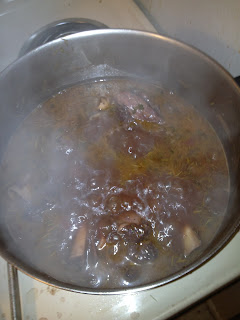This is the first time I've ever attempted cooking lamb, but I looked at a lot of information before proceeding. I was nervous, but I think I did the animal justice in honoring the meat it gave up for me. Our local grocery shop had lamb shanks on sale, and rather than do what I normally do and pass over the "weird meat" to get to the regular stuff, I took a pause and made a challenge to myself.
Three days later, I met that challenge. Here's how it went down.
To start, I had six shanks, roughly one pound each. I rinsed each one and removed the little bone covering thing on the foot end. Then I applied salt and pepper generously.
Three carrots, sliced thin. Two medium onions, chopped. TEN CLOVES OF GARLIC, minced. That's right, TEN CLOVES. I had a head of garlic that was roughly ten cloves all said and done, so really, it's a matter of 3 (carrots), 2 (onions) 1 (head of garlic).
I let the shanks rest with the salt and pepper, then decided I should coat the other side with salt and pepper, too.
A big pot with a small amount of olive oil was needed, so I supplied. Medium-high heat, enough to get the meat to sizzle.
I did two sets of three in the pan to maximize the flesh to hot surface ratio. These things are shaped kinda weird, so it took some inventive holding methods to get all sides to brown.
After browning, I set the shanks aside to rest and dropped the veggies into the oil. About six minutes was what was necessary to get the onions to clarify and the carrots to turn tender. At this point, I smelled a little bit of the sugar in the carrots begin to caramelize.
One big can of tomatoes, one small can of chicken broth, one small can of beef broth, and one bottle (750 ml of red wine. I bought this one because it had a picture of a big cock on the bottle. These go into the veggies in reverse order (wine first), and only are added one at a time when the previous liquid just barely begins to boil.
Once all the liquids are added, re-introduce the shanks, and add a healthy bunch of fresh thyme and fresh rosemary. If I had to give a measurement, I'd say about a quarter cup of each. Stir and bring to a boil.
Shanks are weird. They're the cankle of the lamb. Well, maybe more like the calf of the lamb. Anyway, they start out looking like this. Notice that there's just a little tiny bit of bone showing on the left. It's browned, and some of the wine has already been soaked up into the meat, but it's a far, far way from being done. Once the mix boils for about twenty minutes, bring the heat down to a simmer.
Two hours or so later (yes, that's right, two hours) you'll get this. Notice how the meat has retracted down into a bunch, leaving a lot of bone exposed? That's what you want. It's still not quite done yet, even at this point, but at least I knew I was on the right path.
While I was waiting, I cut up a big batch of potatoes and started the boil. I like to cook a few cloves of garlic in the bottom of the emptied pan with some butter before putting the potatoes back in and mashing. Adds flavor or something.
Okay, see how the meat is starting to just... I don't know... FALL AWAY from the bone? Yes. The connective tissue in that knee/calf area is starting to really liquidize now. Almost ready.
Other side of same shank. The meat almost bulges with the liquid from the braise.
I have to be honest for a second here: I seriously almost just started eating this right here and right now. The smell from the sauce (what with the thyme and rosemary and metric shit-ton of garlic) was just like those heavenly beckoning hands of smoke from cartoons. But, I had to stay strong. I had to let it really finish.
The pot of liquid starts to take on a homogenized appearance at some point, when the fat and connective tissue gets released out into the wine and broth. Everything just tends to meld together into something altogether heavenly.
The main recipes I read said to remove the shanks, skim the fat, and boil the liquid, but I was all like, "AW HELL NAW!" I didn't want to lose out on all that flavor... So I took out the shanks (and put them in a 350 degree oven to keep warm), and busted out the immersion blender and made the remains into a thick sauce. THIS I boiled for about fifteen minutes.
And then I poured that OMG awesome sauce over the shanks.
And then I let it all kinda rest for a little while as the table was set, and the kids washed hands and etc.
The pairing with the mashed potatoes was pretty brilliant, if I do say so myself, as the gravy was, you know, right there... I also added some baked croissant biscuit things, you know, to help out with the gravy.
All in all, I think the meat was really rich. Far richer than I thought it would be. There's a very real dark power to the gentle lamb, I know this now. They keep that darkness below their knees. And it is delicious.






































































